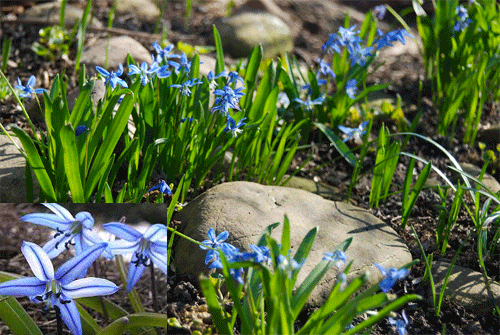Scilla is the sweetheart of the woodland and rock garden. It grows well in partial shade and in less than perfect soil. It is even deer resistant! It belongs to a genus of 50-80 species of flowers. The nodding, somewhat star-shaped flowers, are commonly blue in color, but also come in white and pink. Look for this petite perennial to flower in spring, though some varieties flower in the autumn.
Scilla is often referred to as an herb, perhaps because the liquid can be extracted and used as an expectorant in cough medicines. It can be planted in the front or border of a flower bed with other spring flowering bulbs or naturalized in or near a wooded area.
Not to scare you, but scilla is a poisonous plant, which basically means you shouldn’t eat it! Perhaps it is appropriate that the genus name is related to Scylla, a monster famously referenced in Homer’s Odyssey as residing adjacent to another grave danger for sailors, Charybdis. To be trapped “between Scylla and Charybdis” has become an idiom in English, roughly equivalent to being caught “between a rock and a hard place.”
When to plant:

Plant in fall after the ground has cooled, which means late September to early October in the northern states (zone 4), and into November in the southern states (zones 6-8). Click on the map (right) to find your hardiness zone using your zip code.
Where to plant:
Plant in full sun to partial shade (it’s okay to plant a few under a deciduous tree). They thrive in USDA Plant Hardiness zones 3-8
Planting depth:
Plant scilla 4 inches deep. The bulbs are rounded, with small points on the tops; these points should be placed facing up.
Spacing:
Scilla grow to approximately 4-8 inches (10-20 cm) high and 4-6 inches (10-15 cm) wide. To avoid crowding of mature plants, they should be planted 4 – 8 inches apart.
How to plant scilla bulbs:
Let’s face it, most bulb planting methods have us spending a lot of time bending over or on our knees. The ProPlugger 5-IN-1 Planting Tool allows you to do most of the hard work of digging your bulb planting holes from a standing position.
To pull plugs, slide the 2″ or 4″ metal depth ring onto the bottom of the main tube to set the desired depth of the planting hole. Or to dig a 6″ deep hole, no depth ring is needed.
(Step, Twist and Pour) Step down on the foot pegs until the depth ring bottoms out against the ground. Give the 5-IN-1 a slight twist to break the soil plug free and pull straight up on the handlebars. To empty the plugs, simply turn the plugger upside down and pour the plugs out of the top of the tube.
The soil gets stored inside the tool as you work, enabling you to dig over a dozen planting holes, one right after another. Place the bulb in the planting hole, pointed tip facing upward. Fill in the hole with the soil you removed with the 5-IN-1. Firm the soil over the bulb with your foot.
Feeding:
When the leaf tips begin to poke out of the ground, apply a 5-10-10 fertilizer. About the time of flowering, top dress with a 0-0-10 or 0-0-50 fertilizer. Fertilize in the spring of each year with a 5-10-10 fertilizer or all purpose fertilizer used for feeding flowers. Mulching around the plants with aged compost or well rotted manure will achieve the same effect as a light feeding of fertilizer.
Hardiness zone:
Scilla is hardy in zones 3-8, depending on variety.
Popular varieties of scilla:
Scilla siberica, aka Siberian squill or spring beauty is one of the more popular varieties of scilla. Other popular varieties include Scilla peruviana (with an awesome shade of blue) and the smaller, carefree blues of S. tubergeniana.
Disease and pests:
Crown rot, a fungus problem that occurs at the base of a plant, can be an occasional problem. Proper spacing and good air circulation are preventative measures. In the case of a severe infestation, dig up the bulbs and discard.
Neil Moran is a horticulturist and author of three books on gardening. He is also the creator and author of the garden blog North Country Gardening.
Be sure to check out the helpful information on our website, including other uses for the ProPlugger including:

